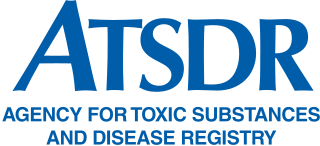Related Research Articles

The Environmental Protection Agency (EPA) is an independent executive agency of the United States federal government tasked with environmental protection matters. President Richard Nixon proposed the establishment of EPA on July 9, 1970; it began operation on December 2, 1970, after Nixon signed an executive order. The order establishing the EPA was ratified by committee hearings in the House and Senate. The agency is led by its administrator, who is appointed by the president and approved by the Senate. The current Administrator is Michael S. Regan. The EPA is not a Cabinet department, but the administrator is normally given cabinet rank.
Broadly speaking, a risk assessment is the combined effort of:
- identifying and analyzing potential (future) events that may negatively impact individuals, assets, and/or the environment ; and
- making judgments "on the tolerability of the risk on the basis of a risk analysis" while considering influencing factors.

Water quality refers to the chemical, physical, and biological characteristics of water based on the standards of its usage. It is most frequently used by reference to a set of standards against which compliance, generally achieved through treatment of the water, can be assessed. The most common standards used to monitor and assess water quality convey the health of ecosystems, safety of human contact, extend of water pollution and condition of drinking water. Water quality has a significant impact on water supply and oftentimes determines supply options.

The Agency for Toxic Substances and Disease Registry (ATSDR) is a federal public health agency within the United States Department of Health and Human Services. The agency focuses on minimizing human health risks associated with exposure to hazardous substances. It works closely with other federal, state, and local agencies; tribal governments; local communities; and healthcare providers. Its mission is to "Serve the public through responsive public health actions to promote healthy and safe environments and prevent harmful exposures." ATSDR was created as an advisory, nonregulatory agency by the Superfund legislation and was formally organized in 1985.

Aquatic toxicology is the study of the effects of manufactured chemicals and other anthropogenic and natural materials and activities on aquatic organisms at various levels of organization, from subcellular through individual organisms to communities and ecosystems. Aquatic toxicology is a multidisciplinary field which integrates toxicology, aquatic ecology and aquatic chemistry.

The U.S. National Ambient Air Quality Standards are limits on atmospheric concentration of six pollutants that cause smog, acid rain, and other health hazards. Established by the United States Environmental Protection Agency (EPA) under authority of the Clean Air Act, NAAQS is applied for outdoor air throughout the country.

The National Energy Technology Laboratory (NETL) is a U.S. national laboratory under the Department of Energy Office of Fossil Energy. NETL focuses on applied research for the clean production and use of domestic energy resources. NETL performs research and development on the supply, efficiency, and environmental constraints of producing and using fossil energy resources, while maintaining their affordability.

A bioindicator is any species or group of species whose function, population, or status can reveal the qualitative status of the environment. For example, copepods and other small water crustaceans that are present in many water bodies can be monitored for changes that may indicate a problem within their ecosystem. Bioindicators can tell us about the cumulative effects of different pollutants in the ecosystem and about how long a problem may have been present, which physical and chemical testing cannot.

An environmental hazard is a substance, state or event which has the potential to threaten the surrounding natural environment or adversely affect people's health, including pollution and natural disasters such as storms and earthquakes.

Oceanic and Atmospheric Research (OAR) is a division of the National Oceanic and Atmospheric Administration (NOAA). OAR is also referred to as NOAA Research.

The Air Resources Laboratory (ARL) is an air quality and climate laboratory in the Office of Oceanic and Atmospheric Research (OAR) which is an operating unit within the National Oceanic and Atmospheric Administration (NOAA) in the United States. It is one of seven NOAA Research Laboratories (RLs). In October 2005, the Surface Radiation Research Branch of the ARL was merged with five other NOAA labs to form the Earth System Research Laboratory.
The Climate Change Science Program (CCSP) was the program responsible for coordinating and integrating research on global warming by U.S. government agencies from February 2002 to June 2009. Toward the end of that period, CCSP issued 21 separate climate assessment reports that addressed climate observations, changes in the atmosphere, expected climate change, impacts and adaptation, and risk management issues. Shortly after President Obama took office, the program's name was changed to U.S. Global Change Research Program (USGCRP) which was also the program's name before 2002. Nevertheless, the Obama Administration generally embraced the CCSP products as sound science providing a basis for climate policy. Because those reports were mostly issued after the Fourth Assessment Report of the Intergovernmental Panel on Climate Change (IPCC), and in some cases focused specifically on the United States, they were generally viewed within the United States as having an importance and scientific credibility comparable to the IPCC assessments for the first few years of the Obama Administration.

Total dissolved solids (TDS) is a measure of the dissolved combined content of all inorganic and organic substances present in a liquid in molecular, ionized, or micro-granular suspended form. TDS concentrations are often reported in parts per million (ppm). Water TDS concentrations can be determined using a digital meter.
Exposure assessment is a branch of environmental science and occupational hygiene that focuses on the processes that take place at the interface between the environment containing the contaminant of interest and the organism being considered. These are the final steps in the path to release an environmental contaminant, through transport to its effect in a biological system. It tries to measure how much of a contaminant can be absorbed by an exposed target organism, in what form, at what rate and how much of the absorbed amount is actually available to produce a biological effect. Although the same general concepts apply to other organisms, the overwhelming majority of applications of exposure assessment are concerned with human health, making it an important tool in public health.
Traditional Ecological Knowledge (TEK) describes indigenous and other traditional knowledge of local resources. As a field of study in anthropology, TEK refers to "a cumulative body of knowledge, belief, and practice, evolving by accumulation of TEK and handed down through generations through traditional songs, stories and beliefs. It is concerned with the relationship of living beings with their traditional groups and with their environment." It is important to note that indigenous knowledge is not a universal concept among various societies, but is referred to a system of knowledge traditions or practices that are heavily dependent on "place". Such knowledge is used in natural resource management as a substitute for baseline environmental data in cases where there is little recorded scientific data, or may complement Western scientific methods of ecological management.

Radiation dose reconstruction refers to the process of estimating radiation doses that were received by individuals or populations in the past as a result of particular exposure situations of concern. The basic principle of radiation dose reconstruction is to characterize the radiation environment to which individuals have been exposed using available information. In cases where radiation exposures can not be fully characterized based on available data, default values based on reasonable scientific assumptions can be used as substitutes. The extent to which the default values are used depends on the purpose of the reconstruction(s) being undertaken.

The United States Environmental Protection Agency (EPA) was established in July 1970 when the White House and the United States Congress came together due to the public's demand for cleaner natural resources. The purpose of the EPA is to repair the damage done to the environment and to set up new criteria to allow Americans to make a clean environment a reality. The ultimate goal of the EPA is to protect human health and the environment.
Radon is a radioactive, colorless, odorless, tasteless noble gas, occurring naturally as the decay product of radium. It is one of the densest substances that remains a gas under normal conditions, and is considered to be a health hazard due to its radioactivity. Its most stable isotope, 222Rn, has a half-life of 3.8 days. Due to its high radioactivity, it has been less well-studied by chemists, but a few compounds are known.
In United States federal environmental legislation, the National Acid Precipitation Assessment Program (NAPAP) was authorized by Congress under the Acid Precipitation Act of 1980 because of concern that acidic deposition might contribute to adverse effects on aquatic systems; agriculture; forests; fish; wildlife and natural ecosystems; materials such as metals, wood, paint and masonry; and public health and welfare.
An early life stage (ELS) test is a chronic toxicity test using sensitive early life stages like embryos or larvae to predict the effects of toxicants on organisms. ELS tests were developed to be quicker and more cost-efficient than full life-cycle tests, taking on average 1–5 months to complete compared to 6–12 months for a life-cycle test. They are commonly used in aquatic toxicology, particularly with fish. Growth and survival are the typically measured endpoints, for which a Maximum Acceptable Toxicant Concentration (MATC) can be estimated. ELS tests allow for the testing of fish species that otherwise could not be studied due to length of life, spawning requirements, or size. ELS tests are used as part of environmental risk assessments by regulatory agencies including the U.S. Environmental Protection Agency (EPA) and Environment Canada, as well as the Organisation for Economic Co-operation and Development (OECD).
References
- National Exposure Research Laboratory; Federal Laboratory Consortium for Technology Transfer website [link accessed on August 31, 2007].
- National Exposure Research Laboratory; West Virginia High Technology Consortium Foundation [link accessed on August 31, 2007].
| Wikimedia Commons has media related to United States Environmental Protection Agency Laboratories . |